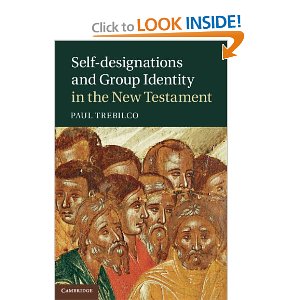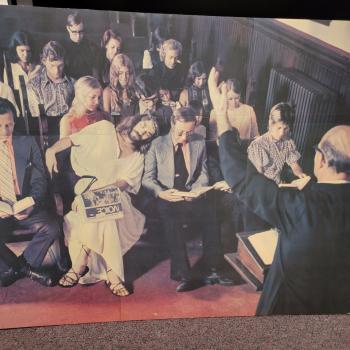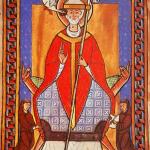Perhaps the most surprising chapter in Paul Trebilco’s new monograph is the one on disciples. The term ‘mathetai’ is used some 261 times in the NT, being by far the most common designation in the Gospels for Jesus’ followers, but it is used nowhere outside the Gospels and Acts in the NT for the followers of Jesus. For example, there is no use of this term anywhere in Paul’s letters or indeed any book that comes after Acts in the canon. We can break down the usage as follows— Mt. 72 times, Mk. 46, Lk. 37, John 78, Acts 28. If you’re wondering the English term ‘disciple’ actually comes from the Latin disciplus which means pupil, and is related to the verb discere– to learn. Literally the term in the Gospel and Acts refers to ‘learners’ (and not to their disciplines of learning or for learning).
Trebilco argues, and I think he is right that Jesus used the Aramaic term talmidayya, which refers to one who engages in learning from another. So a person is a learner from a particular teacher or school. The term is exceedingly common in Greek sources prior to the time of the NT and in Greco-Roman sources as well, and here is a good place to stress that the term is not a technical term for followers of Jesus, even in the NT. John the baptizer has disciples, and they are referred to not only in the Gospels but also in Acts 19 as people who only know about the baptism of John and have not heard of the Holy Spirit! To see the early use of this term in a pedagogical context see Plato’s Republic 618C or Protagoras 343A. By the time we get to master teachers like Epictetus and others in the first century the term has almost a technical sense of adherents and apprentices of a famous master teacher not just a learner.
We find little use of such terms in the MT, but talmid does occur in 1 Chron. 25.8 and Is. 8.16 Is. 54.13 are exceptions to this rule. Surprisingly, mathetai does not turn up in the LXX. The closest parallels to what we find in the NT is from Josephus who uses the term in question some 15 times as he tries to relate Jewish groups and ideas to a Greco-Roman audience. So for example in Ant. 9.68 he refers to Elijah sitting with his disciples. Only much later in Jewish literature does the term ‘disciple’ refer to one who has devoted himself to Torah and studied it under a rabbi (see M. Aboth 1.1). This is a good place to put in the cautionary word that it is always a mistake to read Jesus and his context anachronistically in light of developments in Judaism that did not transpire until after the Fall of Jerusalem in 70 A.D. and in some cases not until after the second Jewish revolt in the 2nd century A.D. when Judaism became well and truly Torah-centric with a fixed canon of Scripture, and even came to repudiate the LXX because it was being used so much by the church in that century as Christian Scripture.
As Trebilco goes on to show, in the case of Jesus’ disciples both senses of the term, a learner, and an adherent, clearly apply. They are not merely students of Jesus, they are also his agents, his adherents, his advocates, and here the term shaliach likely comes into play (translated apostolos), though oddly Trebilco does not deal with that term.
What he does deal with is the fact that we may indeed have an explanation of why the term disappears after Acts. The term refers to some one responding to a direct call by Jesus, literally following Jesus around the Holy Land, leaving their home and livelihood, risking danger and the possibility of loss of life for being a Jesus follower, denying oneself and following Jesus. Note that this involved a wider group than just the 12 though they are the core group of male disciples, and there was a similar core group of female disciples (see Lk. 8.1-3). If this is the job description of a disciple of Jesus, then in several senses there were none after the first batch died out during the period largely described in Acts. Jesus was no longer around to learn from personally, and no one was following him around after his ascension. The other components of discipleship however, including being called by Jesus personally, as Paul was on Damascus road, did continue.
Since we have done a separate post on ‘disciples’ recently on this blog, I do not intend to reiterate what was said there, in this post, but it is worth emphasizing that we normally find the term in the plural. Being a disciple is not about having an individual tutor named Jesus. It is a group phenomena.
It is possible that we see the transition in Acts. 11.25-26 to a different label… moving from disciple to ‘christianos’. We will talk about that label later, but this text suggests that nomenclature other than disciple began to be used of Jesus’ adherents in Antioch, where, not incidentally we have the first real mixing of Jewish and Gentile followers of Jesus. It seems reasonable to suggest that the term Jew was no longer seen as adequate to describe this group because it involved uncircumcised, non-observant Gentiles who were not God-fearers, hence the term ‘Christianoi’. More on this in a subsequent post on this book. Trebilco seeks to make the case that the Evangelists are implying that the disciple label would be o.k. to use in their audiences, but this is not clear from the rest of the NT, which is silent on the matter. It may be so, but if so, why do we see no evidence of it elsewhere, not even in Paul. The term mathetai only rarely comes up in the Apostolic Fathers. Basically it is only found in Ignatius except for 2 references in the Martyrdom of Polycarp, which makes clear that this term was not much used beyond the time of the ministry of Jesus in Christian communities. In the end Trebilco admits (p. 246) that the term does not seem to have been used much if at all in some cases by Christians as a self-designation after Easter.













